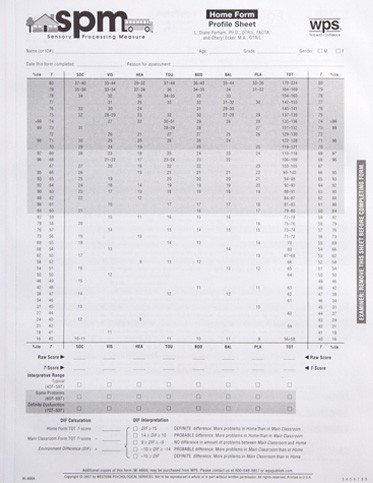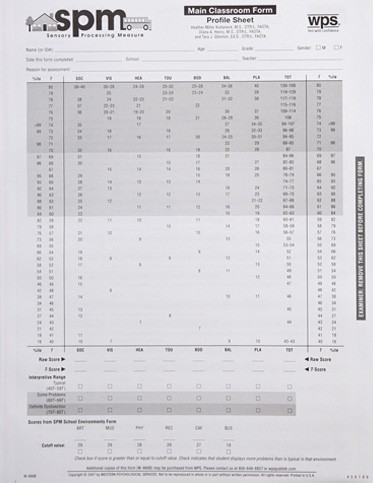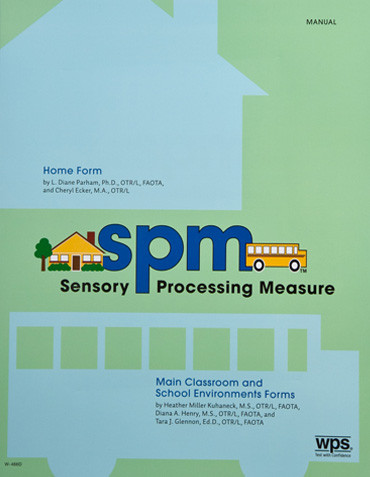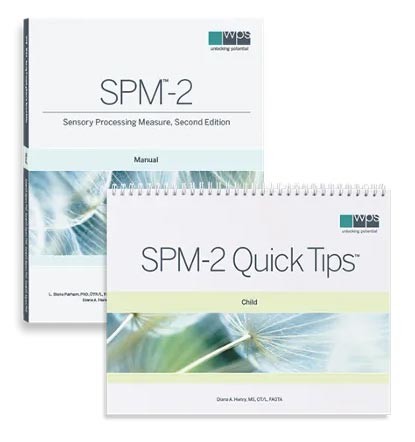*DISCONTINUED (*NEW EDITION in Alternatives below)
With the Sensory Processing Measure (SPM), you get a complete picture of children’s sensory functioning at home, at school, and in the community. Recognizing that sensory processing problems often manifest differently in different environments, this set of three integrated rating scales assesses sensory processing, praxis, and social participation in elementary school children. The assessment’s unique multi-environment approach lets you see, for example, why a child who functions well in a highly structured classroom may have problems in a more relaxed setting.
Firmly grounded in sensory integration theory, the SPM provides norm-referenced standard scores for two higher level integrative functions—praxis and social participation—and five sensory systems—visual, auditory, tactile, proprioceptive, and vestibular functioning. Within each system, it offers descriptive clinical information on processing vulnerabilities, including underand overresponsiveness, sensory-seeking behavior, and perceptual problems.
SPM Forms
The Main Classroom Form (62 items) is filled out by the child’s primary classroom teacher. The School Environments Form (10 to 15 items per environment) is completed by other school personnel who work with and observe the child. And the Home Form (75 items) is completed by the child’s parent or home-based care provider.
Main Classroom and Home Forms
Each requiring just 15 to 20 minutes, the Home and Main Classroom Forms yield eight parallel standard scores:
- Social Participation
- Body Awareness (proprioception)
- Vision
- Balance and Motion (vestibular function)
- Hearing
- Planning and Ideas (praxis)
- Touch
- Total Sensory Systems
Scores for each scale fall into one of three interpretive ranges: Typical, Some Problems, or Definite Dysfunction. An Environment Difference score permits direct comparison of the child’s sensory functioning at home and at school.
School Environments Form
This form lets you look at the child’s functioning in six school environments outside of the main classroom: Art Class, Music Class, Physical Education Class, Recess/Playground, Cafeteria, and School Bus. Each environment has its own Rating Sheet, which can be printed and distributed to raters as needed. The School Environments Form must always be administered in
conjunction with the Main Classroom Form.
Comprehensive, Clinically Rich, and Psychometrically Sound
The Home Form and Main Classroom Form were standardized on a demographically representative sample of 1,051 typically developing children from kindergarten through sixth grade. A subsample of 306 children from the standardization sample was used to develop scores and establish cutoff criteria for the School Environments Form. Studies reported in the Manual document that the SPM differentiates typical children from those with clinical disorders.
Whether you’re an occupational therapist, psychologist, teacher, social worker, counselor, physical therapist, speech-language pathologist, or nurse, you’ll find the SPM comprehensive and clinically rich. It supplies the information you want and the psychometric integrity you need.
-

Sensory Processing Measure (SPM)
SPM Home AutoScore Forms (25)
$110.40 -

Sensory Processing Measure (SPM)
SPM Main Classroom AutoScore Forms (25)
$110.40 -

Sensory Processing Measure (SPM)
SPM ONLINE Home Form (25 Uses)
WPS Online Evaluation System
$93.60 -

Sensory Processing Measure (SPM)
SPM ONLINE Main Classroom Form (25 Uses)
WPS Online Evaluation System
$93.60 -

Sensory Processing Measure (SPM)
SPM ONLINE School Environments Form (Unlimited Use)
WPS Online Evaluation System
$74.40
- Copyright 2010

 Proud to be Canadian
Proud to be Canadian

